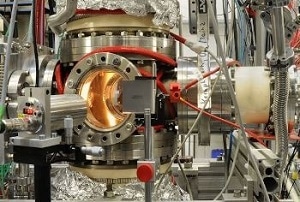Sep 30 2016
 Gas cell used to receive the nobelium isotopes, containing the filament, laser ionization region, and alpha detectors above and below. Credit: UNIVERSITY OF LIVERPOOL
Gas cell used to receive the nobelium isotopes, containing the filament, laser ionization region, and alpha detectors above and below. Credit: UNIVERSITY OF LIVERPOOL
The journal Nature has published a study explaining the successful application of laser spectroscopy in order to reveal the atomic structure of Nobelium, a transfermium element, for the first time.
Fusion evaporation reactions were used at the GSI Helmholtzzentrum in Darmstadt, Germany, to produce nobelium atoms.
A high energy 217 MeV beam of 48Ca ions was used by researches in a break-through experiment to create an impact on thin lead foil targets that are enriched isotopically. This was followed by velocity-filtering the Nobelium products inflight, and then decelerating and delivering them into a buffer gas cell.
A set of five tuneable lasers were used in an extensive search of a theoretically probable, but broad frequency range for an optical resonance.
Neutral atoms were constantly pulse-heated off a catcher filament, examined with the help of a two-step resonance ionization process, and the Nobelium ions detected through their characteristic alpha decay fingerprint.
Success was achieved at rates as low as 1 atom for each second, enabling location of an excited atomic state in similar heavy elements.
Comprising no primordial isotopes highlights that unlike standard optical spectroscopy for nuclear structure research, the atomic physics was totally unheard of, and could be studied only “live” at an accelerator facility, with beam time at its best.
Scanning the first laser beam in high resolution now opens up exciting ways for physicists to study a number of fundamental properties, including the hyperfine structure, unveiling isotopic changes in nuclear charge radius, shape, magnetic moment and spin. Scanning the second (ionising) step permits an extraction of the ionisation potential via the converging Rydberg series.
Bradley Cheal, Department of Physics, University of Liverpool
The experiments were performed by a global collaboration of scientists from GSI, the Helmholtz Institute Mainz, Johannes Gutenberg University Mainz, Technical University Darmstadt (Germany), KU Leuven (Belgium), and TRIUMF (Vancouver, Canada).
Researchers from the Department of Physics (Dr Cheal and PhD student Calvin Wraith) were part of the experiments. For several months, Calvin visited GSI for the important preparatory work ahead of the accelerator beam time.
Source: https://www.liverpool.ac.uk/